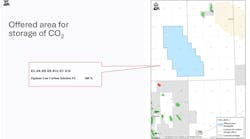GEOPHYSICS Coherence Cube reveals stratigraphic features more readily than traditional 3D time slice plots
Buried channels and faults become readily visible
Dev George
Managing Editor
Cut-away of seismic cube of Pinnacle Reef.
A new development from the geophysical labs at Amoco takes 3D seismic data and, in a non-traditional procedure, processes it not for imaging reflections, but for imaging discontinuities. As a consequence, when visualized in a 3D volume or cube, coherence coefficients are revealed as numerically separated surfaces, stratigraphic features and faults that are often not visible in traditionally processed data.
Both amplitude time and horizontal seismic slices have been used to display 3D data in map or horizontal form, but amplitude time - a horizontal plane through the data volume - is often difficult to interpret, since it is done without picking or a reference to a stratigraphic horizon.
Tradeoffs are unavoidable under traditional methods of 3D seismic data visualization. Stratigraphic features and faults are frequently difficult to see due to the low level of reflection they provide. Likewise, it is often necessary to examine a multitude of vertical cross-sections to determine the lateral extent of faulting, even though faults are rather easily seen on single vertical cross-sections. Thus to trace stratigraphy and faults laterally, it is usually better to use time slices, but their interpretation is frequently complicated by their transit of different stratigraphic horizons.
Employing the seismic amplitudes associated with a consistent interpreted horizon surface can usually help in avoiding this occurrence, but interpretative bias can enter the data set when using horizon slices in tracing faults and stratigraphic features, since a geoscientist is required to go through the difficult and time-consuming process of picking the horizon and usually leaves his mark on the data.
Coherence Cube
Series of coherence slices through the reef (red = low, blue = high coherence).
Amoco's Coherence Cube differs considerably from the traditional 3D seismic cube. Licensed to Houston-based Coherence Technology Corporation, the technique can be used to create new 3D data volumes or cubes of coherence coefficients which facilitate modeling and visual interpretation and can considerably improve an explorationist's chances of finding hydrocarbons by indicating faulting where fault plane reflections were not visible under traditional procedures.
This is the case because estimates of 3D dimensional seismic coherence are obtained by calculating localized waveform similarities in both in-line and cross-line directions within the regular grid of a 3D seismic data set. A sharp discontinuity in local trace-to-trace coherence is produced by a difference in seismic character between small regions of traces cut by a fault and those of neighboring traces. By calculating this coherence for each grid point along a time slice, features of low coherence along faults are indicated. Although fault plane reflections have not been recorded, the lineaments that are produced ultimately become fault surfaces when these calculations are done for a series of time slices. Likewise, stratigraphic boundaries also produce such discontinuities.
The coherence algorithm is not an interpretative process, thus can achieve results much faster than traditional 3D seismic interpretation techniques, saving enormous amounts of time in these days of giant surveys with multi-millions of traces.
In areas such as the Gulf of Mexico, where high seismic amplitudes are frequently indicative of hydrocarbon accumulations, their stratigraphic and structural milieu is more readily identified from coherence data because they provide a different perspective in combination with amplitude data.
Traditional amplitude time slices have long been valuable for viewing faults that are perpendicular to strike, but when they are parallel to strike, they are often indistinguishable from bedding lineaments. Because coherence calculations effectively remove the bedding by reducing and sometimes eliminating laterally consistent features, the 3D coherence algorithm indicates faults regardless of their orientation.
Analysis techniques
A comparison of coherence image (l) and conventional seismic (r).
Several techniques are available for identifying difficult-to-see faults on interpreted surfaces, including estimation of dip magnitude or dip azimuth, and edge enhancement, but they can only be utilized following interpretation of a succession of horizons by a geoscientist, if a 3D perspective of the faults is to be achieved. Such a procedure requires highly accurate interpretation and the effective use of autotracking software. (In circumstances where the wrong horizon is picked analysis based on that pick is skewed by a discontinuity confirmed by the dip, azimuth, or edge map.)
Coherence maps can look fuzzy and out of focus in areas of poor data quality, compared to traditional dip, azimuth, edge detection, and residual analysis techniques, even though the traditional approach includes false linear and circular features. On the other hand, if the data is of high quality, and if the horizon autotracker is efficient and operated by a reliable interpreter, coherence will highlight faults along a horizon just like in the more traditional procedure. Furthermore, stratigraphic features frequently are better imaged by application of the coherence technology.
Faults produce low coherence surfaces during the calculation of a 3D data volume's coherence because they separate from their background data numerically, but they can, nevertheless be seen in three dimensions and from any perspective with the aid of visualization software, despite there having been no fault planes recorded. And, because they are numerically separate from the adjacent data, they can readily be picked with horizon autotracking software, making it possible to have a fault picked on each trace and important details added to the interpretation.
Coherence Technology Corporation's new technique of identifying, imaging, and autotracking faults and often indistinct stratigraphic features in 3D seismic data via its discontinuity and coherence should have far-reaching consequences in hydrocarbon exploration and development and prove to be an important supplement to traditional amplitude data processing and analysis.
Copyright 1996 Offshore. All Rights Reserved.







